Ezra Pound, by Wyndham Lewis
“Pound was friends with (former lover of?) HD (he was sort of the Kevin Bacon of modernism)” — Caroline Small
“Wow, I didn’t realize Pound actually knew Beerbohm. It’s that Kevin Bacon thing….” — Noah Berlatsky
What were you thinking, my learnèd colleague and fellow Utilitarian Caro?
What on Earth could connect Ezra Weston Loomis Pound (1885–1972), the modernist Poetic Master of the Revels, author of the Pisan Cantos…to the respected Hollywood actor Kevin Norwood Bacon (1958– ), the sensitive megastar of classic films such as Animal House and My Dog Skip ?
Kevin Bacon wants YOU!
The answer is–
More, much more than you would think!
There is a theory that all humans are connected by a limited amount of connections, or degrees of separation– A knows B, B knows C, C knows D, thus indirectly connecting A and D. Spooky mad genius Stanley Milgram (1933- 1984) demonstrated that the average number of degrees of separation between Americans was 3.
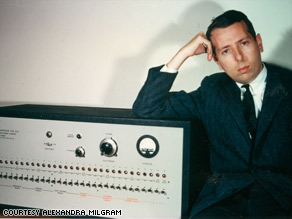
Stanley Milgram, thinking up new ways to screw with your brain
The notion of the average number being six originated with playwright John Guare:
“I read somewhere that everybody on this planet is separated by only six other people. Six degrees of separation between us and everyone else on this planet. The President of the United States, a gondolier in Venice, just fill in the names. I find it A) extremely comforting that we’re so close, and B) like Chinese water torture that we’re so close because you have to find the right six people to make the right connection… I am bound to everyone on this planet by a trail of six people.”
— John Guare, Six degrees of Separation
Naturally, when first I heard of this theory I scoffed.
“Oh, scoff!”, I thought, “so I’m only separated by six people from the Queen of England?”
Wait a minute…
My mother was a close friend of actress Tippi Hedren, who held me in her arms when I was a baby.

Hedren starred in the films The Birds and Marnie, directed by Alfred Hitchcock.
Hitchcock was knighted by Queen Elizabeth II.
I was separated from Her Majesty by only 3 degrees.
What about Hitler?
I knew my father, of course.
He once met Charles De Gaulle at a reception.
De Gaulle once served as the aide of Philippe Pétain.
Pétain was the head of state of Vichy France, put there by Adolph Hitler.
Four degrees from Alex Buchet to Adolph Hitler.
So, where does Kevin Bacon come in?
A popular party game, ‘Six Degrees of Kevin Bacon’, purports to link the hard-working actor to any of his thespian colleagues in 6 degrees or fewer.
For example:
Alfred Hitchcock was in Show Business at War (1943) with Orson Welles, and
Orson Welles was in A Safe Place (1971) with Jack Nicholson, and
Jack Nicholson was in A Few Good Men (1992) with Kevin Bacon.
Find the Bacon is a website where you can play this intellectually stimulating pastime ad libitum.
Back to Ezra:
When Caro likens Pound to Bacon, she is pointing out his extraordinary connectivity as a writer, editor, mentor and critic. Dozens of writers and artists counted among his acquaintances. He was a true nexus of the Modernist movement.
Ez hangin’ with the homeboys from his posse: (left 2 right) Ford Madox Ford, James Joyce, Ezra Pound, John Quinn.
But can he not be even more connected?
How many degrees separate Ezra Pound from another American artistic Titan of the 20th century, Jerry Lewis?
How to get from here:

…to here?

The American part of me looks askance at such a possible connection; the French part of me rejoices, knowing better, agreeing with the dictum of Bartleby‘s author:
“For genius, all over the world, stands hand in hand, and one shock of recognition runs the whole circle round”.
—Herman Melville, “Hawthorne and his Mosses,” The Literary World, August 17 and 24, 1850
Ezra Pound: Pavannes and Divisions (1916)
Let’s put this to the test.
Ezra Pound’s mugshot. Scary dude, eh?
Ezra Pound was the editor of Thomas Stearns Eliot (1888 – 1965).
T.S. Eliot, by Wyndham Lewis
Eliot was a friend of Julius Henry “Groucho” Marx (1890-1977).
(No joke; Groucho loved Eliot’s poetry, and Eliot was a huge Marx Brothers fan; he wanted to pen a screenplay for Sweeny Agonistes, the film to star Harpo Marx as Sweeny.)
Art by Al Hirschfeld
Groucho starred in the 1949 film Love Happy, written by Frank Tashlin (1913- 1972).
Tashlin used to be a comic strip artist under the pseudonym ‘Tish-Tash’. Hey, this is a comics blog — I get my justification where I can find it.
Tashlin, starting with Rock-a-Bye Baby (1958), directed 6 films starring Jerome Levitch, a.k.a Jerry Lewis (1926- )
Jerry Lewis ALSO wants you!
So that’s 4 degrees of separation between these two cultural masters.
Of course, it’d be easy to link Pound to Frank Sinatra (1915-1998) from here: merely note that Dean Martin (1917-1995) was Jerry’s comedy partner, and that Martin co-starred with Sinatra in such Rat-Pack fare as Robin and the 7 Hoods. This gives us two more degrees of separation, for a total of 6.

Ring-a-ding-o!
But can’t we link the theorist of Vorticism and the Chairman of the Board of Entertainment in a more streamlined way, I hear you ask?
Natch, Clyde.
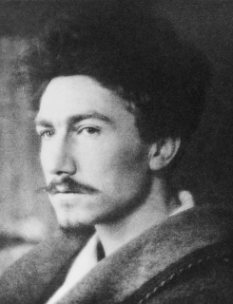
Ezra Pound edited and published A Portrait of the Artist as a Young Man, by James Joyce (1882 -1941).

Joyce’s secretary was once Samuel Beckett (1906-1989).

Beckett wrote the screenplay for the 1964 short movie, Film, starring Buster Keaton (1895-1966).

Keaton made a cameo appearance in the 1956 movie Around the World in Eighty Days, as did Frank Sinatra.
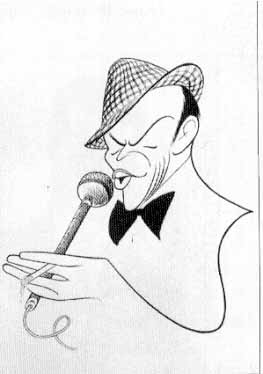
Art by Al Hirschfeld
There! Four degrees of separation — so much more elegant.
How to reach from Ezra to Joe Dimaggio (1914-1999), though? Two such revered icons of American civilisation must be connectable.
And Joe, like Ezra, was no stranger to poetry.
Witness this 1941 song by Ben Honer and Alan Courtney, as performed by Les Brown and sung by Betty Bonney:
Hello Joe, whatta you know?
We need a hit so here I go.
Ball one (Yea!)
Ball two (Yea!)
Strike one (Booo!)
Strike two (Kill that umpire!)
A case of Wheaties
He started baseball’s famous streak
That’s got us all aglow
He’s just a man and not a freak,
Joltin’ Joe DiMaggio.
Joe, Joe DiMaggio
We want you on our side
He tied the mark at forty-four
July the 1st you know
Since then he’s hit a good twelve more
Joltin’ Joe DiMaggio
Joe, Joe DiMaggio
We want you on our side
From coast to coast that’s all you’ll hear
Of Joe the one man show
He’s glorified the horsehide sphere
Joltin’ Joe DiMaggio
Joe, Joe DiMaggio
We want you on our side
He’ll live in baseball’s Hall of Fame
He got there blow by blow
Our kids will tell their kids his name
Joltin’ Joe DiMaggio
We dream of Joey with the light brown plaque
Joe, Joe DiMaggio
We want you on our side
And now they speak in whispers low
Of how they stopped our Joe,
One night in Cleveland Oh Oh Oh
Goodbye streak DiMaggio
Closer to our troubled times, 1966’s song from the film The Graduate –as sung by Simon and Garfunkel— Mrs Robinson, in its final peroration eerily echoes Pound’s Hugh Selwyn Mauberly (1920) and its disillusionment and pessimism in a world where the notion of a hero is an empty mockery:
Where have you gone, Joe DiMaggio,
Our nation turns it’s lonely eyes to you.
Woo, woo, woo.What’s that you say, Mrs. Robinson?
Jotting Joe has left and gone away,
Hey hey hey.
Ah hey hey hey.

The Yankee Clipper: Joltin’ Joe
Go back to Groucho. That film Love Happy was also the debut of Marilyn Monroe (1926-1962)…who of course married Joe Dimaggio.

Awwwww…
Four degrees.
What of Kevin Bacon, though? How does he connect to Ezra?
Ezra Pound…

…was the editor of Ernest Hemingway (1899- 1961).

Hemingway’s novels A Farewell to Arms and For Whom the Bell Tolls were adapted as films, starring Gary Cooper (1901- 1961), who became a friend.

Cooper also starred in Sergeant York (1941), along with June Lockhart (1925– )

June is first from left in panel 4; art by Mort Drucker
And in 1989, Lockhart acted in the movie The Big Picture, alongside Kevin Bacon.
Four degrees.
What about myself?
Among the surrealists Pound mingled with in Paris was the painter Max Ernst (1891- 1976)
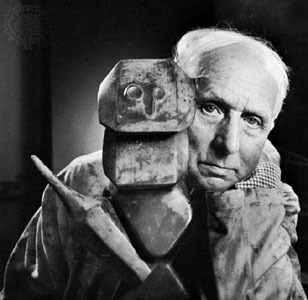
In 1974, Ernst met Alex Buchet (1954– ) at a cocktail party.
(His only words to me were: ‘You thought I was dead, didn’t you?’)
Two degrees of separation.
Challenge to the Reader! (apologies to Ellery Queen)
Ezra Pound to Ernest Borgnine in 3 degrees.
Art by Wyndham Lewis
Here’s the answer: to read it, drag your mouse cursor over the text while pressing the left-hand button.
Pound edited Ernest Hemingway.
Hemingway was a friend of Gary Cooper, who starred in 2 film adaptations of his novels.
Cooper and Ernest Borgnine both appeared in the film Vera Cruz (1950).
But no fair peeking before you’ve tried.
And dear Reader– hypocrite lecteur, mon semblable, mon frère!– by all means post in ‘comments’ your own challenges.
For those of you who think I’ve overloaded this post with pictures:
It is better to present one image in a lifetime than to produce voluminous work.
–Ezra Pound




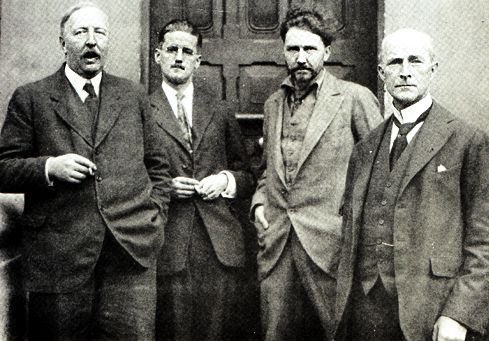
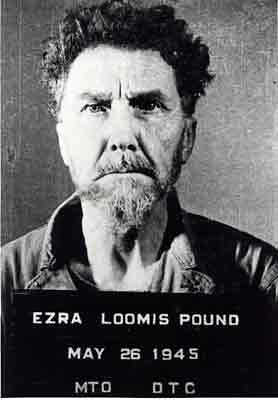


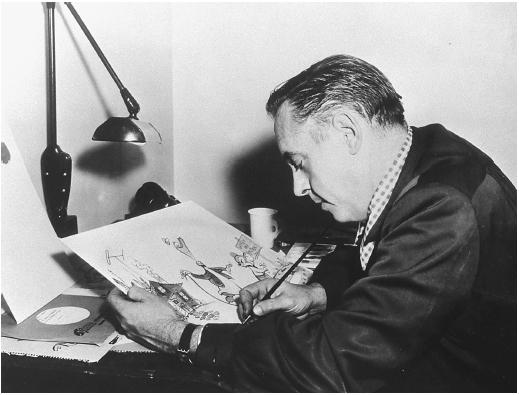


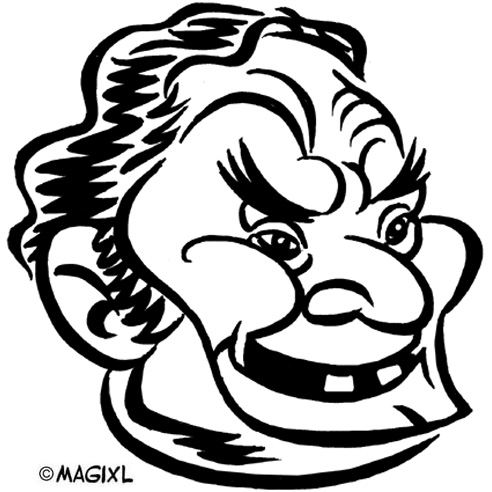
“(His only words to me were: ‘You thought I was dead, didn’t you?’)”
That is hilarious.
Did he mistake you for a super-villain, Alex?
Eh, he was a radioactively bitter ghost at the feast.
Guys, I was only 19 and an art student! Fear and awe!
It was an odd introduction.
The person who’d invited me thought that a)I would obviously benefit from meeting this legend, and b)Ernst would benefit from meeting young people.
But the man’s hostility was so strong…had I been a couple of years older, I would have pressed him to communicate. But at the time, I was as shy as a chapel mouse.
One of (many) lost opportunities in my life…
Ummm…plus…to be perfectly honest, I actually HAD thought he was dead.
This would be a great idea for a book, if you could clear the illo rights.
But I caveat the Pound-Lewis connection. We don’t know that Groucho met Tashlin, only that they were engaged in the same professional venture.
For my part, I once had a therapy session with Alissa Kwitney’s mother (whom I liked a great deal), which puts me two separations from Neil Gaiman and, as a result, three from just about everyone else on earth.
Huh! I once met Robert Sheckley. That puts me twp degrees away from you.
As for Groucho and Tashlin: the Marx Brothers had an extraordinary (for the times)amount of control and involvement with their films. Far from being the merry anarchists they depicted, they were hard-headed comedy pros: when possible, they ‘road-tested’ all their routines and skits (famously with ‘The Coconuts’) on stage before incorporating gags into their films, ruthlessly discarding anything that didn’t get enough of a laugh.
Now, they did employ some of the wittiest screenwriters around, such as S.J. Perelman, George S. Kaufman, and Bert Kalmar.But they always added gags and dialogue to the script; these were very rarely ad-libs. They worked closely with the screenwriter.
It is not likely that they were simply presented with a finished Tashlin screenplay and ordered, “Film this”. I am 99% sure that Groucho– the most literate of the brothers, and their only theorist of story and comedy– worked directly with Tashlin.
So, phooey, Tom!
Well, even if you don’t believe that Groucho worked directly with Tashlin in Love Happy, Groucho did have a cameo in the Tashlin-directed feature Will Success Spoil Rock Hunter? So you could use that as their “connection” instead if you wanted…
Thanks, Ilj.
That connection also leads to Charles Manson…work it out, True Believers!
“So, phooey, Tom!”
Oh yeah? Try this on for size.
Love Happy was the last Marx Bros film and they made it only because Chico needed help with his gambling debts. How involved were they in its making? My guess: not very.
So far from being road tested, the film barely got made. The production ran out of money and United Artists had to scrape some up by means of product placement, hence a chase scene constructed around advertising displays for actual products.
In fact road testing was the exception, not the rule, for Marx Bros films. It was Irving Thalberg’s idea and they started it when they came to MGM. Coconuts, a Paramount feature, wasn’t road tested. It was an actual Bway hit that got made into a movie.
So don’t you try to out-Marx me, pal.
That being said, the Tashlin connection by means of Will Success Spoil Rock Hudson sounds entirely plausible.
… so Neil Gaiman met Dick Cheney, who met Silvio Berlusconi …
I am six degrees of separation from Nicole Minetti, among others. Wow.
This is the best blog post ever.
What I want to know is whether, now that we live in an e-Society, knowing someone on the Internet counts for the separation. Like, can I connect myself to Pound through Alex, or do I have to wait until I someday meet Alex in person? Or is it contingent upon how well one e-knows someone else?
I think e-knowing has to count. Because I say so. And it is my blog.
I can easily see how the average American can have three degrees (or less) of separation from everyone else.
For example, I’ve met the four folks below, so imagine how many people I only have two degrees of separation from:
Ed Bradley
Stan Lee
Richard M. Daley
Barack Obama
This all reminds me of the little quip my dad, with a twinkle in his eye, would recite on occasion: “I shook the hand that shook the hand that shook the hand of Babe Ruth.”
Me and Ed Bradley in 1994 in Haiti: http://home.comcast.net/~russ.maheras/Russ-Ed_Bradley-Haiti-1994.JPG
I’m not in this 2005 photo of then Sen. Barack Obama because was too busy taking the photo: http://home.comcast.net/~russ.maheras/Barack-Sox-72dpi.jpg
This raises another issue: I have a photograph of myself in a department store in Williamsburg, VA with Imelda Marcos. (I’m serious, yes, a department store. No shoe jokes allowed.)
I wouldn’t count her as a source of such connections though, because she doesn’t know MY name. (Not to imply that these people wouldn’t know you, Russ; it just made me think of this example.)
That’s right isn’t it? Each party has to know the other by name before you can count them? Otherwise it’s badly skewed in favor of famous people.
Or is it being skewed in favor of famous people the reason why it works, as Russ sort of implies?
I think knowing each other’s names is a good rubric. And it’s still pretty easy to get to a large range of people. I’m two degrees from Barack Obama, for example (I know someone who knows him — not surprising since he lives down the street from me.)
With as many senior leaders I’ve worked with, deciding who “knows” who gets really complicated.
What do I mean? Well, someone like Mayor Daley or President Obama gets briefed before every formal event as to who they will be introduced to, or what “significant” guests are in attendance.
So, while a major campaign conributor, business leader or fellow politician (and their spouses) may get acknowledged repeatedly by a senior politician (even by their first name) over a period of years, it’s entirely possible the politician wouldn’t recognize the individual at all in an informal exchange.
I don’t really “know” and of the four folks I listed.
In Stan’s case, over a span of more than 35 years we’ve met about six times, and he sent me a personal letter once. Back in the late 1970s, I even spent about 45 minutes with him once on the Kennedy Expressway in Chicago, driving him from the convention hotel downtown out to O’Hare International Airport. But obviously I don’t “know” him. Heck, from what I hear about Stan’s memory, I’ll bet there are people he worked with for years who he wouldn’t recognize or recall their names.
Still, using name recognition as a filter isn’t bad.
That’s a good point about the leadership events: my name recognition metric actually might only work for the Kevin Bacon game because the celebrities in question know each other’s names the same way we know their names. They might have just barely met, or met once. I guess that’s Tom’s point about the Marx Bros, isn’t it…
I don’t think Groucho and Tashlin met at all when it came to making Love Happy. Someone handed Groucho the script, he said what he was supposed to, then got out of there.
As far as I’m concerned, a meeting with an exchange of names is enough. Russ’s 45 minutes in traffic with Stan is plenty.
Was Stan really cheerful and chipper thru it all? That’s what I like to think.
Oh, yeah! He was the Stan I imagined the whole time he was in the car.
Ironically, I wasn’t originally the guy scheduled to take him to the airport. I was just snagged at the last second by a couple of the con organizers (who I’d known for years) and asked if I could drive Stan to O’Hare.
Naturally, I said “sure,” and Stan, me and another long-time Chicago fan and pal of the con organizers, Ron Massengill, piled into my 1977 Toyota Celica. Ron — a very big guy back then — took up most of the cramped back seat, and Stan road shotgun.
Most of the conversation was a blur to me (Ron seems to remember more), but that’s probably because I was driving. I do remember Stan relating how he hated disappointing fans who came up to him with their scripts or artwork asking him to evaluate their work, because almost always is just wasn’t pro caliber (more on this later).
I also remember at one point in bumper-to-bumper traffic, Stan noticed a bumper sticker on a camper in front of us and pulled out a little black book so he could write down the quote: “I may be slow, but I’m ahead of you.” Stan said something to the effect that he always carried that book with him to jot down ideas.
As we neared O’Hare, good ol’ Ron told Stan what a “great artist” I was, and how I had my portfolio in the trunk, yadda, yadda, yadda. Stan, totally forgetting what he had said about wannabe fans just a half-hour or so earlier, turned to me brightly and said something like “Really? Can I see it?”
At the time, I was a recovering Marvel Zombie and a died-in-the-wool comic book artist wannabe, and the idea of Stan personally examining my portfolio (even right outside the departure area of O’Hare) was probably the greatest opportunity I could have imagined at that moment in time.
But I said, “No.”
Why? Because, as I explained to Stan, I hadn’t forgotten what he had said, and I didn’t want to put him in an awkward position, maybe forcing him to praise work he may not have otherwise praised.
Stan seemed genuinely taken aback, probably because he either said what he said earlier in passing and didn’t remember saying it, or he realized that what he said may have kept him from discovering the next Berni(e) Wrightson. He asked me to reconsider, but being the stubborn young maverick that I was, I was like, “No, Stan, I don’t want to put you on the spot.”
So we all shook hands and Stan headed inside.
Ron thought I was nuts, and, in the years immediately following, I occasionally wondered the same thing.
But decades later, in retrospect, I’d glad I did what I did.
For, while I wasn’t a bad artist, I certainly was no Berni(e) Wrightson — meaning the likelihood of me getting steady work for an entire career was probably exceedingly slim.
Wow, I think he was taken aback by a fan displaying that much class and self-sacrifice. I would have gone ahead and shown him the stuff, but I admire your choice.
On a different note … great as Stan is, the below pretty much sums up my idea if his artistic process:
“Stan noticed a bumper sticker on a camper in front of us and pulled out a little black book so he could write down the quote: ‘I may be slow, but I’m ahead of you.’ Stan said something to the effect that he always carried that book with him to jot down ideas.”
“Your seconds are numbered, Webslinger! You’re getting slower … tired!”
“I may be slow, but I’m ahead of you!”
I’m with Russ…myself, I’m uncomfortable in the presence of famous people. What can you say except lame compliments?
Caro, there’s a giant Vorticism retrospective show at the Guggenheim in Venice. Must be a site about it somewhere…
The black book thing may actually explain some of the divergent memories among the principles (Lee, Kirby, Ditko, etc.) about who created what back in Marvel’s formative Silver Age years.
Think about it. Stan reads or hears a quip, idea, or whatever that he thinks is interesting, and writes it down in his little black book, a binder in his office desk drawer, or whatever. Then weeks, months, or years later, while flipping through his notes, he gets inspired to create character, villain, or plot.
Stan has stated over and over he has a poor memory, so it’s unlikely he’d remember where the original idea or note came from. Thus, when asked about a character or plot-creation process decades after the fact, it makes sense that from his point of view, he’d believe that such creations sprung, whole cloth, from his brain.
My cousin is friends with prince harry who obviously friends with the queen. So that’s only three steps from me to the queen of England :) and then I can get to loads of political leaders from there because the queen has met them?